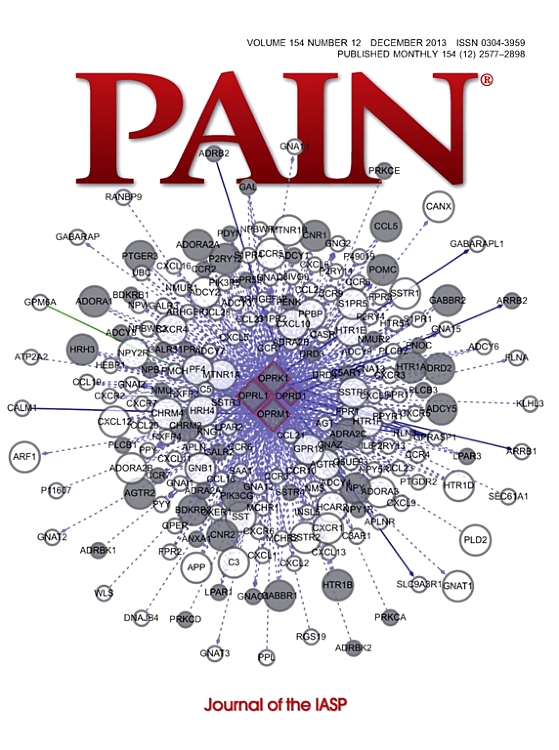Diminished transient receptor vanilloid 1 on skin nerve fibers in painful bortezomib-induced peripheral neuropathy.
IF 5.9
1区 医学
Q1 ANESTHESIOLOGY
引用次数: 0
Abstract
Bortezomib-induced peripheral neuropathy (BIPN) is frequently accompanied by reduced thermal sensation and neuropathic pain. We explored the relation between transient receptor vanilloid 1 (TRPV1) receptors on skin nerves and BIPN pain. We combined PGP9.5 and TRPV1 immunofluorescence labelling on skin biopsy sections from 67 individuals, 27 patients with BIPN without pain, 18 patients with BIPN with pain, and 22 healthy volunteers. A total of 332 bioimages were collected and quantified using objective image analysis. qPCR was used to measure TRPV1 mRNA in the skin. Quantitative sensory testing and pain questionnaires were used to gather clinical data. Transient receptor vanilloid 1 immunoreactivity appeared as distinct puncta along the nerve fibers. Its normalized mean fluorescence intensity (TRPV1/PGP9.5 MFI) (P < 0.05) and TRPV1 puncta area (P < 0.001) were decreased in small nerve fibers of patients with BIPN, concomitantly with reduced thermal sensitivity. Further stratification based on pain symptoms demonstrated a greater reduction in TRPV1/PGP9.5 MFI and severe impairment in thermal difference detection ability (TSL) and heat pain thresholds (HPT) in painful BIPN. Pain levels were negatively correlated with TRPV1/PGP9.5 MFI in the epidermis and subepidermis (P < 0.001 r = -0.44; P < 0.001, r = -0.42), and with z-scores of TSL and HPT (P < 0.05; P < 0.05). Transient receptor vanilloid 1 mRNA levels in skin were not different between groups, indicating that cellular synthesis of TRPV1 was not altered. Diminished TRPV1 immunoreactivity on nerves of patients with BIPN with pain aligns with their insensitivity to thermal stimuli which may help to better understand the pathophysiology of pain in patients with BIPN.疼痛性硼替佐米诱导的周围神经病变中皮肤神经纤维瞬时受体香草样蛋白1的减少。
硼替佐米诱导的周围神经病变(BIPN)经常伴有热感觉减少和神经性疼痛。我们探讨皮肤神经瞬时受体香草样蛋白1 (TRPV1)受体与BIPN疼痛的关系。我们将PGP9.5和TRPV1免疫荧光标记联合应用于67名个体、27名无疼痛BIPN患者、18名有疼痛BIPN患者和22名健康志愿者的皮肤活检切片。采用客观图像分析方法对332张生物图像进行定量分析。采用qPCR检测皮肤中TRPV1 mRNA的表达。采用定量感觉测试和疼痛问卷收集临床资料。瞬时受体香草样蛋白1的免疫反应性表现为沿神经纤维有明显的斑点。其归一化平均荧光强度(TRPV1/PGP9.5 MFI) (P < 0.05)和TRPV1点面积(P < 0.001)在BIPN患者的小神经纤维中降低,同时热敏性降低。基于疼痛症状的进一步分层显示,疼痛性BIPN中TRPV1/PGP9.5 MFI有更大的降低,热差检测能力(TSL)和热痛阈值(HPT)严重受损。疼痛水平与表皮和皮下TRPV1/PGP9.5 MFI呈负相关(P < 0.001 r = -0.44;P < 0.001, r = -0.42),与TSL、HPT的z-score (P < 0.05;P < 0.05)。皮肤中瞬时受体香草样蛋白1 mRNA水平在两组之间没有差异,表明TRPV1的细胞合成没有改变。伴有疼痛的BIPN患者神经上TRPV1免疫反应性降低与他们对热刺激的不敏感相一致,这可能有助于更好地理解BIPN患者疼痛的病理生理。
本文章由计算机程序翻译,如有差异,请以英文原文为准。
求助全文
约1分钟内获得全文
求助全文
来源期刊

PAIN®
医学-临床神经学
CiteScore
12.50
自引率
8.10%
发文量
242
审稿时长
9 months
期刊介绍:
PAIN® is the official publication of the International Association for the Study of Pain and publishes original research on the nature,mechanisms and treatment of pain.PAIN® provides a forum for the dissemination of research in the basic and clinical sciences of multidisciplinary interest.
 求助内容:
求助内容: 应助结果提醒方式:
应助结果提醒方式:


